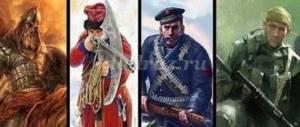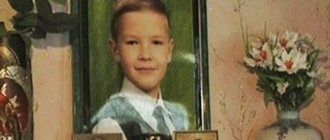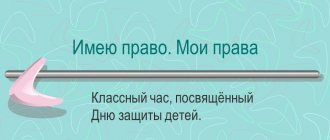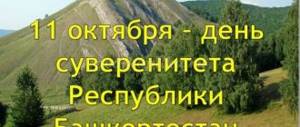Class hour, 4th grade. Holocaust
Class hour in 4th grade “The Holocaust: memory and prevention”
Explanatory note Subject – class hour Grade – 4 Topic – “Holocaust: memory and prevention” Purpose: to introduce students to the history of the Holocaust. Objectives: - educational: familiarizing students with some documents and photographic materials on the history of the Holocaust; — developing: • formation of tolerant consciousness; • formation of historical thinking and sympathy for the victims of genocide; — educational: instilling in students an understanding of the danger of the spread of fascism. Relevance. In our time, the topic of the Holocaust has not lost its relevance;
social tension, interethnic and interfaith conflicts, surges of extremism and neo-fascism - all this forces us to remember the Catastrophe of European Jewry. Teaching method: visual-practical, verbal. Class hour script.
Organizing time. Updating knowledge. Self-determination of the topic of the lesson. (Two students read a poem) Holocaust (Friedrich Zolotkovsky) My people shed a sea of tears, no matter where they were scattered... War is always a Holocaust - not only for Jews... In the fields, and in the pits, and in the forests, and in camps, and in the ghetto, in the Nazi gas ovens they tormented us... Not a song from the ancient books was sung, not a word was said, not a verse... But in the sound of the wind and banners, where the army passed, my Jewish people were buried in mass graves... And I dream about one thing: so that people of different faiths end the war with leprosy. Everyone's land is our common home! We have been talking about this for centuries, but everywhere there is blood, and death, and smoke... Teacher. — What will we talk about during the class hour? (Student responses) - What is the Holocaust? The word "Holocaust" comes from the Greek holo "whole, whole" and kaustos "combustible, burnt." It means an animal sacrifice in which the entire body is burned. The Holocaust is also known as Shoah, which means "destruction, destruction" in Hebrew. The terms "Shoah" and "Final Solution" always refer to the Nazi extermination of the Jews, and the common noun "Holocaust" refers to Nazi genocide in general; "Holocaust" can mean the mass extermination of any group of people by any government. Confirmation that the Holocaust happened are documents and photographs. Very often these photographs were taken by the SS men themselves, eager for thrills. Or their accomplices - as proof of diligent service: the living who are thrown into the ditch with the dead, skeletons covered in skin, children on the verge of starvation. Shot, strangled, tortured... Historical facts (Trained student) The Holocaust began in January 1933, when Hitler came to power, and actually ended on May 8, 1945. On September 1, 1939, the Second World War began. German troops destroyed everything in their path. Between 1933 and 1945, more than 11 million men, women and children were killed during the Holocaust. Approximately six million of them were Jews. On November 9, 1938, Kristallnacht or the Night of Broken Glass occurred in Germany and Austria, when the Nazis treacherously attacked Jewish communities. The Nazis destroyed, looted and burned more than 1,000 synagogues and destroyed more than 7,000 businesses. They also destroyed Jewish hospitals, schools, cemeteries and homes. When it was all over, 96 Jews had been killed and 30,000 arrested. Jews were required to wear special signs on their clothes, armbands with six-pointed stars; in many cities it was forbidden to walk on sidewalks, use public transport, or enter central areas... (Student reads a poem) Two triangles - a star. Shield of the forefather. Father David Election is not an insult, a Sacred gift, not a misfortune. There was grief here - grief without counting. Yellow stars are stars of honor. Stars of the humiliated, stars of the rejected, Sewn into the sky of Jewish clothing. Yellow stars, stars of David, Bitter tears of Jewish resentment. More than 1.1 million children died during the Holocaust. Children were particularly targeted by the Nazis during the Holocaust. Alive, they posed an exceptional threat, because, having matured, they would have created a new generation of Jews. Many children suffocated in cattle trucks on the way to the camps. Those who survived were immediately placed in gas chambers. Ghetto (Trained Apprentice) A ghetto is a part of a city surrounded by barbed wire or walls where Jews from surrounding areas were required to live. In the early stages of the extermination of European Jews, the Nazis forcibly moved them into ghettos and followed a policy of indirect extermination, depriving Jews of their basic means of subsistence. In the largest Warsaw ghetto in Poland, about 1% of the population died every month. As a rule, ghettos were created in settlements with railway connections, so that their inhabitants could later be easily transported to death camps. Approximately 1/3 of the Jewish people living at that time were killed in the Holocaust. An estimated 220,000-500,000 Roma were killed during the Holocaust. Death Camps (Trained Apprentice) Six death camps were created in Poland, where the Jewish population of Europe was to be deported (Treblinka, Chelmno, Sobibur, Majdanek, Auschwitz and Belzec). In these camps, the extermination of people was carried out on an industrial basis. They equipped gas chambers and ovens for burning corpses. Those arriving at the railway stations of the death camps were directed to the “showers” under the pretext of undergoing sanitary processing. Cyclone B gas was supplied to the room - and after 5 minutes all the people died. The German leadership created a wide network of various types of camps. The first concentration camp in Germany was created almost immediately after Hitler came to power, in 1933 on the outskirts of the town of Dachau. In 1937, the Buchenwald concentration camp was built near Weimar. The Buchenwald concentration camp is world famous for the inscription above the entrance “Jedem das Seine” (to each his own). Buchenwald (7 students read a poem) It sounds beautiful - Buchenwald, The mountain and the valley are covered with forest, But what is clouding my vision? There is a bloody veil in the eyes. Death has hovered here for eight years, There are continuous brands on the rags, And it is impossible to see What is down there - the magical Weimar. There - Goethe wrote “Fausta”, Here - the flames of death raged There - “People are dying for metal”, Here - people are dying from metal. There - Wieland, Schiller, Herder, Bach, There - Cranach, fabulous and bright. Here are machine guns on poles and grazing fierce shepherd dogs. There lived the great Franz Liszt, Who sang music about freedom. Here they hit a rusty sheet with a sledgehammer, driving people to work. There is a graceful Belvedere, There the spirit of the arts is healthy and ardent. And here is a fascist officer with a grin, aiming at the back of the head. There - the Muses came out on parade, Here - there are statues of death everywhere. Sounds beautiful - Buchenwald?! What a terrible name! By order of Heinrich Himmler on April 27, 1940, the Auschwitz concentration camp was created. On June 14, 1940, the first transport - 728 Poles - was brought here. On the territory of Poland, the Czech Republic, Latvia and other Eastern European countries there were also camps Majdanek, Salaspils and many others. There were about 14 thousand concentration camps. Gas Chambers (Trained Apprentice) Gas chambers originally used carbon monoxide. Later, the insecticide Zyklon B was developed to kill prisoners. When the prisoners were in the cell, the doors were sealed and Zyklon B balls were dropped into the ventilation inside the walls, spreading poisonous gas. SS doctor Johann Kremer said that the victims were screaming and fighting for their lives. Victims were found with blood coming from their ears and foaming at the mouth in a semi-sitting position in cells with space available only for standing. During the Holocaust, gas entered the chambers from below and then slowly rose to the ceiling, forcing victims to climb on top of each other to breathe air. Those who were stronger were often found on top of piles of bodies. In some concentration camps, prisoners were subjected to medical experiments by exposing the body to various conditions, such as placing them at high altitudes, exposing them to low temperatures or extreme atmospheric pressure. Others were used in experiments with diseases such as hepatitis, tuberculosis and malaria. Dr. Josef Mengele's Experiments (Trained Apprentice) Those who were subjected to Dr. Josef Mengele's experiments were almost always killed and dissected. Many children were maimed or paralyzed, and hundreds died. The children called him “Uncle Mengele,” and he brought them candy and toys before killing them with his own hands. He later drowned in Brazil in 1979. Nazi doctor Josef Mengele, also known as the "Angel of Death", admired the twins. According to one eyewitness, in an attempt to create conjoined twins, he sewed two twins named Guido and Nino, who were about 4 years old, back to back. Their parents managed to obtain morphine and kill their children to end their suffering. Babi Yar (Trained Disciple) The largest mass murder of the Holocaust occurred in September 1941 at Babi Yar near Kiev in Ukraine, where more than 33,000 Jews were killed in just two days. The Jews were forced to undress and go to the edge of the ravine. When German troops fired at them, they fell down. Then the Nazis filled up the walls of the ravine, burying both the dead and the living. The police grabbed the children and also threw them into the ravine. In his memoirs, Rudolf Hess described how Jewish children were deceived into the gas chambers. To avoid panic, they were told that they needed to undress for showering and disinfection. The Nazis used "Special Squads" (other Jewish prisoners) who kept the situation calm and helped those who refused to take off their clothes. The children often cried, but after being consoled by Special Squad members, they entered the gas chambers laughing, playing, or chatting with each other, often still holding toys. Mom, I’m scared... (Valeria Koryukina, 16 years old) (Student reads a poem) “Mom, I’m scared!” “Don't be afraid, baby. It won't take long - Imagine that you are sleeping. Close your eyes and remember me... Then everything is like in a fairy tale. The whole family is together.” “Mom, it hurts me! For what?! Why?!" "Enough! Enough! Tell him!" “Mom, save me! I don’t want to die!” “Hide it! Take it away! We are tired of suffering. Death has already turned its face…” “Mom, don’t cry! I will die a brave man!” Cruelty (Trained Apprentice) Concentration camp workers were forced to run in front of SS officers to show that they still had strength. SS officers directed the runners into one of two lines. One line went to the gas chambers. The other was returning to the barracks. The fleeing workers did not know where each of them was going. The Nazis processed the hair of Holocaust victims into felt and thread. Hair was also often used to make socks and insoles for submarine crews, for bomb fuses, rope, ship cords, and for stuffing mattresses. Camp commanders were required to submit monthly reports on the amount of hair collected. Monuments to the victims of the Holocaust Currently, on the territory of Babi Yar there are several monuments and memorial complexes to the victims of the Holocaust. Monument to the victims of the Holocaust in Hungary, Donetsk, Minsk. International Holocaust Remembrance Day is celebrated on January 27. Established by the UN General Assembly on November 1, 2005. The date January 27 was chosen because on this day Soviet troops liberated the Auschwitz concentration camp (Poland). Teacher. What is the overall significance of the Holocaust for each of us? (Students' answers) Teacher. And the Holocaust is not only a tragedy of the Jewish people, it is a Catastrophe of all humanity, it is, in essence, a crisis of world civilization, which continued in Afghanistan, Yugoslavia, Israel, Chechnya, and in terrorist attacks around the world. And we must not forget about this, and we must pass on our knowledge to our children and grandchildren. They must know the truth and be convinced of it. I hope that after our class hour you realized and felt the whole tragic essence of the word “Holocaust”. Summary of the lesson. Questions. 1. What is the Holocaust? 2. Which people suffered the most? 3. How do you understand what a “ghetto” is? 4. What fate awaited the people who ended up in the ghetto? 5. What do people need to remember so that such a terrible story never repeats itself? Teacher. A scribe sat in Auschwitz, Counted no worse than a robot - From mothers with babies How many hairs were obtained. I. Ehrenburg The history of the Holocaust helps us understand how prejudices, prejudices, and false judgments give rise to practical racism. The history of the Holocaust also teaches us how modern technology can be used to destroy people.
We recommend watching:
Class lesson summary on the topic: My family is my wealth, 4th grade Conversation with elementary school students on the topic: Signs Class hour 3rd - 4th grade. My friend - book Thematic class hour on ecology, grades 3-4
Similar articles:
Class hour 4th grade. Russia is my homeland
Class hour 4th grade. Communication culture
Class hour. Tolerance 4th grade
Cool hours in 4th grade
Class hour 4th grade. Teach yourself to study
International Holocaust Remembrance Day. Class hour for elementary school, 3rd grade
Class hour “Dedicated to the memory of children - victims of the Holocaust”
Objectives: Educational:
- familiarize students with the tragedy of the Holocaust as one of the examples of inhumanity;
— increasing information literacy of students. Educational:
- familiarization with the chronology of the Holocaust tragedy;
- fostering a tolerant attitude towards people of different nationalities, a sense of empathy, compassion for other peoples. - development of the ability to listen to another person, the ability to sympathize, empathize. Developmental:
- continued development of monologue speech skills, development of communication skills that strengthen social ties.
Equipment:
— Exhibition of books on the topic of the Holocaust; — Newspaper clippings, newspapers and magazines; — Printed photographs, illustrations on the topic;
Progress of the class hour:
1. Organizational moment. 2. Introduction to the topic. Pay attention to the design of the board... When do you think this was? (Children's answers...). Yes, it was a terrible time, the time of the Holocaust. Leafing through the dictionary, you can determine the meaning of this word like this... “Holocaust” (Greek) - destruction by fire, sacrifice, “SHOA” (Hebrew) - trouble, catastrophe. (The teacher hangs a poster on the board that depicts a vase with the inscription Holocaust and a decoding of the inscription. Flowers of the group will be symbolically placed in it) This was not only a misfortune of one nation, many people of different nationalities died at that time. Look: one person was given food for 184 kal per day, this is a cucumber, a tomato, a piece of dry bread, is it possible to live if you only eat this? In fact, you and I need a lot of calla lilies - 3500 - in order to be strong and healthy. This is why the Holocaust is compared to a catastrophe, because to this day no one knows the exact number of victims. We will go far into the past... And let's try to find out about this time. Task 1: Read the information for the group, choose the main thing, tell others. Task 2: Color your own flower (for each student). 3. Main part. Work in groups under the guidance of a teacher (high school student). After reviewing the information, the group works on coloring the flowers. The assignments take 10 to 15 minutes. 3 minutes for the group report. 1935 In September 1935, the Nuremberg Laws were passed. Thus, the Nazis deprived Jews of all civil rights. In schools, students were introduced to tools with which it was supposedly possible to determine the racial characteristics of people: with instruments and tables that helped to measure and evaluate the size of cheekbones, eye and hair color. The symbol of the group is a pale pink flower (1935) lying on the table. After the rest of the students have read the information, the flower is placed in a symbolic vase - a poster. 1938 On the night of November 10, a pogrom occurred, which went down in history as Kristallnacht (Night of Broken Glass). Then about 100 Jews died, all synagogues in Germany were destroyed, and more than 7,000 Jewish shops were looted. The group's symbol is a pale blue flower (1938) lying on the table. After the rest of the students have read the information, the flower is placed in a symbolic vase - a poster. 1941 -1945 With the outbreak of the war, the Nazis captured countries and regions with densely populated Jewish populations. In large cities (much less often - in small ones, ghettos were created where the population of the city and surrounding areas were herded. The symbol of the group is a scarlet or red flower (1941-1945). The flower, after familiarizing the rest of the students with the information, is placed in a symbolic vase - a poster. Teacher: You ask, how did people live in that terrible time? How did they recognize who was one of their own and who was a stranger? And very simply, they were given away by their appearance, And most often, by someone’s denunciations. High school student: The Nazi death camps were intended for the mass extermination of people Unlike other camps, which served primarily as prisons and penal colonies, extermination camps (also called extermination camps) were exclusively “death factories.” The SS and police exterminated approximately 2,700,000 people in the extermination camps using gas poisoning. or executions. The symbol is a black flower, in the hands of a high school student. After familiarizing the rest of the students with the information, the flower is placed in a symbolic vase - a poster. Generalization of what has been learned. Let's sum it up, it was a scary time. Many people dedicated books, articles, and paintings to these events. This topic also impressed me and I wrote a poem about the Holocaust. Reading a poem of your own composition: The Holocaust The past will remind us of many things. About those terrible days, When the victims of the Holocaust died. That list is endlessly terrifying. Where people died, families died. Never tell them how they wanted to live their lives. Who divided them, who dared?! To say that you are not ours, not yours. Who took the life? Who didn't give it? Who killed? Did you shoot? Who burned? Who stood aside?! A movie from the past for us... But still, this terrible hour The fire took their souls. And the world became gloomy, And peace suddenly went into the distance... And forever that day became Memorial Day for us. We are all silent under the metronome And with every sound there is pain in the heart. It’s impossible to list all the names... And only a flower lay on the marble, giving respectful honor. Nature is frozen and waiting. When will this day pass? But a minute lasts slowly... And the metronome, as if slowing down, makes the beat of the heart. Minute of silence (metronome sound).
Laying flowers-colorings, symbolically around a vase with flowers-symbols.
Teacher: Let's remember the lessons of the past and not repeat mistakes in the future!
We recommend watching:
Class hour in 2nd grade, dedicated to the International Day of Peace Class hour on patriotic education, grades 3-4 Scenario of the patriotic hour “Afghan Pain” for students in grades 4-6
Similar articles:
Scenario of a literary and musical composition for primary schoolchildren “Children and war are incompatible”
Extracurricular event for schoolchildren “Victims of the Holocaust”



